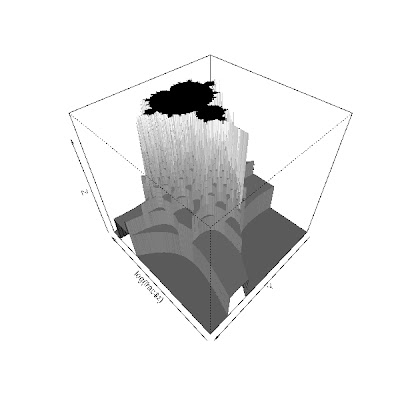BMat=rbind(c(0.333,0,0,0.333,-0.333,0),c(0.167,-0.289,0.289,0.167,-0.0830,0.144),c(0.167,0.289,-0.289,0.167,0.083,0.144),c(0.333,0,0,0.333,0.333,0))
# Initial conditions:
x=0
y=0
plot(0,0,xlim=c(-0.5,0.5),ylim=c(0,1),col="white")
COLOR=c("green","red","blue","yellow")
for(j in 1:10000)
{
i=sample(1:4,1) # ,prob=c(0.25,0.25,0.25,0.25)
x3=x
x=BMat[i,1]*x+BMat[i,2]*y+BMat[i,5]
y=BMat[i,3]*x3+BMat[i,4]*y+BMat[i,6]
points(x,y,pch=".",cex=1, col=COLOR[i])
}
Thursday, March 29, 2007
Wednesday, March 21, 2007
A flower?
BMat=rbind(c(2/3,1/3,0,2/3,0,2/3),c(-1/3,1/3,0,1/3,-1/3,2/3),c(2/3,1/3,1/3,1/3,1/3,2/3),c(1/3,0,2/3,-2/3,1/3,0))
# Initial conditions:
x=0
y=0
X11()
plot(0,0,xlim=c(-1,3),ylim=c(-1,3),col="white")
COLOR=c("green","red","green","red")
for(j in 1:30000)
{
i=sample(1:4,1) # ,prob=c(0.25,0.25,0.25,0.25)
x=BMat[i,1]*x+BMat[i,2]*y+BMat[i,5]
y=BMat[i,3]*x+BMat[i,4]*y+BMat[i,6]
points(x,y,pch=".",cex=1, col=COLOR[i])
}
# Initial conditions:
x=0
y=0
X11()
plot(0,0,xlim=c(-1,3),ylim=c(-1,3),col="white")
COLOR=c("green","red","green","red")
for(j in 1:30000)
{
i=sample(1:4,1) # ,prob=c(0.25,0.25,0.25,0.25)
x=BMat[i,1]*x+BMat[i,2]*y+BMat[i,5]
y=BMat[i,3]*x+BMat[i,4]*y+BMat[i,6]
points(x,y,pch=".",cex=1, col=COLOR[i])
}
Mandelbrot set
Here you can find the code for the Mandelbrot set:
http://tolstoy.newcastle.edu.au/R/help/03b/3377.html
http://tolstoy.newcastle.edu.au/R/help/03b/3377.html
Barnsley fern
BMat=rbind(c(0.849,0.037,-0.037,0.849,0.075,0.183),c(0.197,-0.226,0.226,0.197,0.400,0.049),c(-0.150,0.283,0.260,0.237,0.575,-0.084),c(0,0,0,0.160,0.500,0))
# Initial conditions:
x=0
y=0
X11()
plot(0,0,xlim=c(0,1),ylim=c(0,1),col="white")
COLOR=c("green","red","blue","yellow")
for(j in 1:10000)
{
i=sample(1:4,1) # ,prob=c(0.25,0.25,0.25,0.25)
x3=x
x=BMat[i,1]*x+BMat[i,2]*y+BMat[i,5]
y=BMat[i,3]*x3+BMat[i,4]*y+BMat[i,6]
points(x,y,pch=".",cex=1, col=COLOR[i])
}
#--------------------------------------#
# Alternative code by Stefano Guazzetti
#--------------------------------------#
# The probabilities used here give more dense fern.
niter<-150000
kind<-sample(1:4, niter, repl=T, prob=c(.01, .07, .07, .85))
x<-numeric(niter+1)
y<-numeric(niter+1)
x[1]<-0
y[1]<-0
for (i in 1:niter) {
x[i+1]<- 0*(kind[i]==1)+(0.2*x[i]-0.26*y[i])*(kind[i]==2)+
(-0.15*x[i]+0.28*y[i])*(kind[i]==3) +
(0.85*x[i]+0.04*y[i])*(kind[i]==4)
y[i+1]<- 0.16*y[i]*(kind[i]==1)+(0.23*x[i]+0.22*y[i]+1.6)*(kind[i]==2)+
(0.26*x[i]+0.24*y[i]+.44)*(kind[i]==3) +
(-0.04*x[i]+0.85*y[i]+1.6)*(kind[i]==4)
}
par(mar=c(0.1,0.1,0.1,0.1))
plot(x, y, pch=17, cex=.3, col="darkgreen", axes=F, ann=F)
# Initial conditions:
x=0
y=0
X11()
plot(0,0,xlim=c(0,1),ylim=c(0,1),col="white")
COLOR=c("green","red","blue","yellow")
for(j in 1:10000)
{
i=sample(1:4,1) # ,prob=c(0.25,0.25,0.25,0.25)
x3=x
x=BMat[i,1]*x+BMat[i,2]*y+BMat[i,5]
y=BMat[i,3]*x3+BMat[i,4]*y+BMat[i,6]
points(x,y,pch=".",cex=1, col=COLOR[i])
}
#--------------------------------------#
# Alternative code by Stefano Guazzetti
#--------------------------------------#
# The probabilities used here give more dense fern.
niter<-150000
kind<-sample(1:4, niter, repl=T, prob=c(.01, .07, .07, .85))
x<-numeric(niter+1)
y<-numeric(niter+1)
x[1]<-0
y[1]<-0
for (i in 1:niter) {
x[i+1]<- 0*(kind[i]==1)+(0.2*x[i]-0.26*y[i])*(kind[i]==2)+
(-0.15*x[i]+0.28*y[i])*(kind[i]==3) +
(0.85*x[i]+0.04*y[i])*(kind[i]==4)
y[i+1]<- 0.16*y[i]*(kind[i]==1)+(0.23*x[i]+0.22*y[i]+1.6)*(kind[i]==2)+
(0.26*x[i]+0.24*y[i]+.44)*(kind[i]==3) +
(-0.04*x[i]+0.85*y[i]+1.6)*(kind[i]==4)
}
par(mar=c(0.1,0.1,0.1,0.1))
plot(x, y, pch=17, cex=.3, col="darkgreen", axes=F, ann=F)
Sierpinsky gasked
# Sierpinsky gasked, Chaos game -algorithm:
X11(width=6,height=6)
plot(0,0,xlim=c(0,1),ylim=c(0,1), col="white")
A=c(0,0)
B=c(1,0)
C=c(0.5,0.8)
D=sample(0:1000,2)/1000
for(i in 1:10000)
{
Corner=sample(1:3,1)
if(Corner==1){CornerS=A}
if(Corner==2){CornerS=B}
if(Corner==3){CornerS=C}
D=(D+CornerS)/2
points(D[1],D[2],pch=".",cex=1)
}
X11(width=6,height=6)
plot(0,0,xlim=c(0,1),ylim=c(0,1), col="white")
A=c(0,0)
B=c(1,0)
C=c(0.5,0.8)
D=sample(0:1000,2)/1000
for(i in 1:10000)
{
Corner=sample(1:3,1)
if(Corner==1){CornerS=A}
if(Corner==2){CornerS=B}
if(Corner==3){CornerS=C}
D=(D+CornerS)/2
points(D[1],D[2],pch=".",cex=1)
}
Subscribe to:
Comments (Atom)
